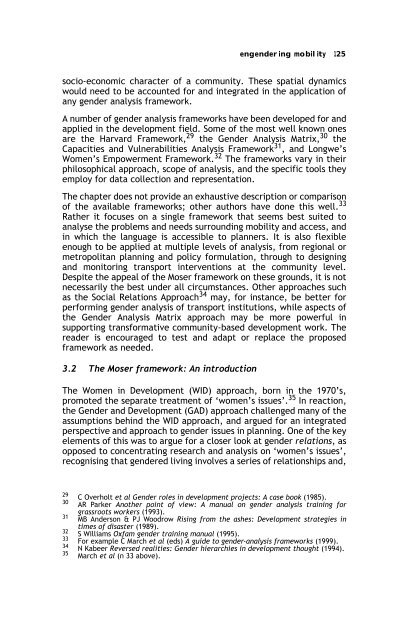Sex, Gender, Becoming - PULP
Sex, Gender, Becoming - PULP
Sex, Gender, Becoming - PULP
You also want an ePaper? Increase the reach of your titles
YUMPU automatically turns print PDFs into web optimized ePapers that Google loves.
engendering mobility 125<br />
socio-economic character of a community. These spatial dynamics<br />
would need to be accounted for and integrated in the application of<br />
any gender analysis framework.<br />
A number of gender analysis frameworks have been developed for and<br />
applied in the development field. Some of the most well known ones<br />
are the Harvard Framework, 29 the <strong>Gender</strong> Analysis Matrix, 30 the<br />
Capacities and Vulnerabilities Analysis Framework 31 , and Longwe’s<br />
Women’s Empowerment Framework. 32 The frameworks vary in their<br />
philosophical approach, scope of analysis, and the specific tools they<br />
employ for data collection and representation.<br />
The chapter does not provide an exhaustive description or comparison<br />
of the available frameworks; other authors have done this well. 33<br />
Rather it focuses on a single framework that seems best suited to<br />
analyse the problems and needs surrounding mobility and access, and<br />
in which the language is accessible to planners. It is also flexible<br />
enough to be applied at multiple levels of analysis, from regional or<br />
metropolitan planning and policy formulation, through to designing<br />
and monitoring transport interventions at the community level.<br />
Despite the appeal of the Moser framework on these grounds, it is not<br />
necessarily the best under all circumstances. Other approaches such<br />
as the Social Relations Approach 34 may, for instance, be better for<br />
performing gender analysis of transport institutions, while aspects of<br />
the <strong>Gender</strong> Analysis Matrix approach may be more powerful in<br />
supporting transformative community-based development work. The<br />
reader is encouraged to test and adapt or replace the proposed<br />
framework as needed.<br />
3.2 The Moser framework: An introduction<br />
The Women in Development (WID) approach, born in the 1970’s,<br />
promoted the separate treatment of ‘women’s issues’. 35 In reaction,<br />
the <strong>Gender</strong> and Development (GAD) approach challenged many of the<br />
assumptions behind the WID approach, and argued for an integrated<br />
perspective and approach to gender issues in planning. One of the key<br />
elements of this was to argue for a closer look at gender relations, as<br />
opposed to concentrating research and analysis on ‘women’s issues’,<br />
recognising that gendered living involves a series of relationships and,<br />
29 C Overholt et al <strong>Gender</strong> roles in development projects: A case book (1985).<br />
30<br />
AR Parker Another point of view: A manual on gender analysis training for<br />
grassroots workers (1993).<br />
31 MB Anderson & PJ Woodrow Rising from the ashes: Development strategies in<br />
times of disaster (1989).<br />
32 S Williams Oxfam gender training manual (1995).<br />
33 For example C March et al (eds) A guide to gender-analysis frameworks (1999).<br />
34<br />
N Kabeer Reversed realities: <strong>Gender</strong> hierarchies in development thought (1994).<br />
35 March et al (n 33 above).
















